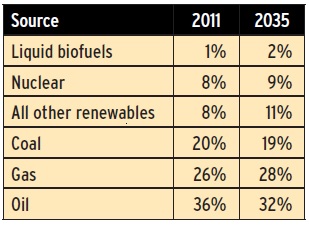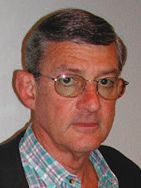Feeling energetic?
Dr. Robert M. Gresham, Contributing Editor | TLT Lubrication Fundamentals July 2013
The tribology community will play a huge role in developing sustainable energy sources.

www.canstockphoto.com
KEY CONCEPTS
• U.S. and global consumption of energy will grow dramatically by 2035.
• A technical infrastructure will be needed to extract, process and develop any new form of energy.
• The STLE community is advancing our understanding of various tribo-chemical processes, all with the goal of reducing friction and wear and conserving energy.
I’m normally a pretty energetic, upbeat kind of guy. But when I read about the various foibles and scandals of our U.S. political class, which seem omnipresent, and turn to the world’s energy needs, which truly is an omnipresent problem and has been for generations, I definitely feel a certain loss of energy.
We’ve evolved from slavery and wood as energy sources to coal, oil, nuclear, gas, solar, wind and a number of emerging ideas about other forms of renewables such as biomass and the like. Estimates from the U.S. Energy Information Administration suggest that U.S. consumption will increase from about 98 x 1015 btu/year to maybe 105 x 1015 btu/year in 2035. For me, 1015 times anything is a bit beyond comprehension.
And this is just in the U.S. Those numbers say nothing about emerging high-growth economies and populations like China and India and, most certainly, the many other countries that make up the so-called Third World economies, which are growing as well. With this perspective, 1015 is now a smallish number. It is mind boggling, at least for my poor, already boggled mind.
Figure 1 depicts where U.S. energy sources are estimated to come from. All other renewables not mentioned in this table include wind, solar, biomass, water, geothermal, hydrogen fuel cells, etc.

Figure 1.
These estimates suggest some harsh realities for us. Research, innovation and subsequent commercialization of new energy technologies can be a slow, cumbersome process when the goal is to impact the 1015 btu/year need. Making rapid changes in energy development is like trying to turn the Titanic just before hitting the iceberg.
Each of the above sources has one thing in common—the need for some kind of infrastructure to create/extract the energy into a useable form and some kind of infrastructure to distribute the energy where it is needed. Some of this infrastructure is in place, some needs to be modified, expanded or upgraded, and some will need to be created from scratch. Again, this will require additional research, innovation and commercialization.
When one looks beyond the U.S., the global community has all the same problems but perhaps in different proportions. The U.S. has its problems marshaling efforts in the governmental and commercial communities to solve these problems in a timely, cost-effective manner. Likewise, the global community also faces these same kinds of challenges. There is no place to hide.
Clearly, oil, gas and coal will continue as our major sources of energy for many years to come, along with the infrastructure for their distribution. Thus, it makes sense to extract, process and utilize these as efficiently and cost effectively as we can. It equally makes sense that as we extract, process and utilize these substances, we do so in a manner that minimizes all forms of pollution and waste—which are actually forms of inefficiency. Thus, we maximize their levels of sustainability.
Equally clear we, as a global community, need to foster research, innovation and commercialization to create and develop new, more sustainable forms of renewable energy and the necessary infrastructures to support them. Some of our current ideas for new energy will not be viable long-term—or maybe even short-term—but even that is alright as we will learn many new lessons in the course of the work, as we did when putting a man on the moon.
This effort will necessarily require sustained discipline and treasure from the global community to be successful. A key part of this effort will be the contributions of the tribological community. Through our research efforts, we develop new materials, chemicals and additives. We’ll also learn to better understand the various tribo-chemical processes, all with the goal to reduce friction and wear and conserve energy. Through our efforts in manufacturing, fleet management and operation of various machinery, we develop improved techniques and processes that conserve energy and reduce friction and wear. Through our efforts in improving machinery maintenance, we reduce friction, wear, downtime, etc., all of which ultimately conserve energy. Thus, we must function efficiently to buy the time needed to develop new solutions to solve the world’s energy needs. Indeed, our ultimate survival depends on it.
When I think of the blathering about energy emerging from the political class, movie stars, various special interest groups and, quite frankly, a few idiots, I feel a genuine loss of energy. When I think of the global technical community, many of whom I have been privileged to meet on my various travels for STLE or at our annual meeting, I feel a surge of energy.
How are you feeling?

Bob Gresham is STLE’s director of professional development. You can reach him at rgresham@stle.org.